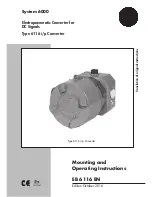
4
GB
Important notice!
Before installing and using this product please read
this manual carefully!
The
Viessmann
accessory decoder 5260 is designed
for model train layouts – exclusively in dry spaces
– for switching turnouts, semaphore signals, Hobby
daylight signals as well as
Viessmann
daylight signal
control modules, relays or uncoupling tracks.
It is to be connected to the Sx-Bus of a SELECTRIX
®
digital command control system (such as e.g. Trix
SELECTRIX
®
, Rauthenhaus Digital, MUET DIGI-
RAIL, etc.).
Any other use beyond the above is considered as
inappropriate. No liability is accepted for defects or
damages resulting from inappropriate use; such risk
is the full responsibility of the user.
Introduction
The accessory decoder 5260 has 8 double outputs
for switching turnouts, semaphore signals, Hobby
daylight signals as well as
Viessmann
control
modules for daylight signals, relays or uncoupling
tracks. The decoder address and the operating mode
(pulsed or continuous output) are set electronically.
After turning on the SELECTRIX
®
-System the decod-
er reports the status of turnouts etc. to the command
station. The decoder has a separate power input for
the operating voltage of the turnout motors.
Connecting the Decoder to the
SELECTRIX
®
System
The decoder is to be wired to the Sx-Bus of the
SELECTRIX
®
command station either directly or
via another accessory decoder, feedback decoder,
controller etc. (see fig. 1). Please note that the power
to the command station must be turned off during
this process.
The sequence of the decoders connected to the
Sx-Bus can be freely selected. They can either be
connected one after the other (in series) or can be
wired in a star arrangement with several branches
coming from distributors.
More than 100 devices can be connected to an Sx-
bus (please refer to the manual of the SELECTRIX
®
command station).
Each decoder 5260 has to be assigned an address
via electronic programming after switching it on for
the first time. The address, like the other parameters,
can be changed at any time as often as desired.
Please note:
This address cannot be used as loco-
motive address at the same time.
Connecting to an Expanded Sx-Bus
Some SELECTRIX
®
systems provide other tact syn-
chronised Sx-bus versions (Sx1, Sx2 etc.) besides
the standard Sx0 bus. Thus the first bus (Sx0) is
fully available for running engines, while the others
can be used for controlling accessories.
The accessory decoder 5260 can be connected to
such Sx-bus systems. Accessory decoders that are
required to provide status feed back from feedback
decoders, have to be wired to the same Sx-bus
and to be set in the same mode as the feedback
decoder.
It is also possible to wire the accessory decoders
to the Sx-bus of a separat SELECTRIX
®
command
station. However, in this case the decoder cannot
provide status feed back, since it only works reliably
in tact synchronised Sx-bus systems.
Connecting the Power Supply
The accessory decoder 5260 receives its power for
switching accessories via the sockets “bn”(+) and “ge”(-)
from a separate transformer (see fig. 2). For assuring
the optimal switching power it is recommended to
use the Power module 5215 as per fig. 3.
Attention!
Any wiring should only be carried out
while the entire system is switched off! Any power
source must be protected in such a way that the risk
of fire (burning cables) in case of a short circuit is
eliminated. Only use commercially available trans-
formers for model trains compliant with VDE / EN!
Turnouts, Un-couplers and Relays
In this section the wiring of accessories is described.
Please always refer to the diagrams at the end of
this booklet. Finally the setting of the operating mode
(pulse or continuous output) is explained.
Important note:
all wiring diagrams as described
here and many other examples are available in
colour at the
Viessmann
web site under
www.viessmann-modell.de
Turnouts:
The wiring of turnouts with or without end
position contacts is shown in fig. 4 (pulsed output).
Turnouts wired in tandem:
two turnouts can be
wired as one but is not recommended when using
the status feed back facility.
Three-way-turnout:
three-way-turnouts are to
be wired to separate decoder outputs just as two
separate turnouts. Before changing the turnout to
a diverging route you may have to set the other part
of the turnout to “straight”.
! Please note !
Only use model-railroad transformers
compliant with the regulations of VDE / EN.
Installation and electrical connection must
be carried out while the supply voltage is
disconnected!


























